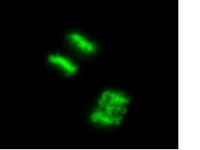17-10229 Sigma-AldrichLentiBrite™ Histone H2B-GFP Lentiviral Biosensor
Empfohlene Produkte
Übersicht
| Replacement Information |
|---|
Key Spec Table
| Key Applications | Detection Methods |
|---|---|
| TFX, IF, ICC | Fluorescent |
| Description | |
|---|---|
| Catalogue Number | 17-10229 |
| Trade Name |
|
| Description | LentiBrite™ Histone H2B-GFP Lentiviral Biosensor |
| Overview | Read our application note in Nature Methods! http://www.nature.com/app_notes/nmeth/2012/121007/pdf/an8620.pdf (Click Here!) Learn more about the advantages of our LentiBrite Lentiviral Biosensors! Click Here Biosensors can be used to detect the presence/absence of a particular protein as well as the subcellular location of that protein within the live state of a cell. Fluorescent tags are often desired as a means to visualize the protein of interest within a cell by either fluorescent microscopy or time-lapse video capture. Visualizing live cells without disruption allows researchers to observe cellular conditions in real time. Lentiviral vector systems are a popular research tool used to introduce gene products into cells. Lentiviral transfection has advantages over non-viral methods such as chemical-based transfection including higher-efficiency transfection of dividing and non-dividing cells, long-term stable expression of the transgene, and low immunogenicity. EMD Millipore is introducing LentiBrite™ Lentiviral Biosensors, a new suite of pre-packaged lentiviral particles encoding important and foundational proteins of autophagy, apoptosis, and cell structure for visualization under different cell/disease states in live cell and in vitro analysis.
EMD Millipore’s LentiBrite™ Histone H2B-GFP lentiviral particles provide bright fluorescence and precise localization to enable live cell analysis of chromosomal dynamics in difficult-to-transfect cell types. |
| Alternate Names |
|
| Background Information | Chromatin, the higher order structure of DNA and nucleosomes, constitutes the majority of the nucleus of the eukaryotic cell. Changes in chromatin structure are the essence of many essential nuclear processes, including transcription, mitosis, meiosis, and apoptosis. The nucleosome comprises an octomer of four core histone proteins (H2A, H2B, H3 and H4). Genetic fusions between histone H2B and fluorescent proteins have been widely used in live cells to visualize the dynamics of chromosomal architecture during various processes. In addition to its utility for studying normal mitosis, histone H2B-GFP has been utilized to define mechanisms for asymmetric inheritance of oncogenic double minute chromosomes. Monitoring histone H2B-GFP also permits continuous analysis of chromosomal degradation during apoptosis. Use of histone H2B-GFP has recently been extended to live animals and high-throughput siRNA screens. EMD Millipore’s LentiBrite™ Histone H2B-GFP lentiviral particles provide bright fluorescence and precise localization to enable live cell analysis of chromosomal dynamics in difficult-to-transfect cell types. |
| References |
|---|
| Product Information | |
|---|---|
| Components |
|
| Detection method | Fluorescent |
| Quality Level | MQ100 |
| Biological Information | |
|---|---|
| Gene Symbol |
|
| Purification Method | PEG precipitation |
| UniProt Number | |
| Physicochemical Information |
|---|
| Dimensions |
|---|
| Materials Information |
|---|
| Toxicological Information |
|---|
| Safety Information according to GHS |
|---|
| Safety Information |
|---|
| Product Usage Statements | |
|---|---|
| Quality Assurance | Evaluated by transduction of HT-1080 cells and fluorescent imaging performed for assessment of target localization and transduction efficiency. |
| Usage Statement |
|
| Packaging Information | |
|---|---|
| Material Size | 1 vial (minimum of 3 x 10E8 IFU/mL) |
| Transport Information |
|---|
| Supplemental Information |
|---|
| Specifications |
|---|
| Global Trade Item Number | |
|---|---|
| Bestellnummer | GTIN |
| 17-10229 | 04053252595943 |
Documentation
LentiBrite™ Histone H2B-GFP Lentiviral Biosensor SDB
| Titel |
|---|
LentiBrite™ Histone H2B-GFP Lentiviral Biosensor Analysenzertifikate
Broschüre
| Titel |
|---|
| New Products: Volume 3, 2012 |









